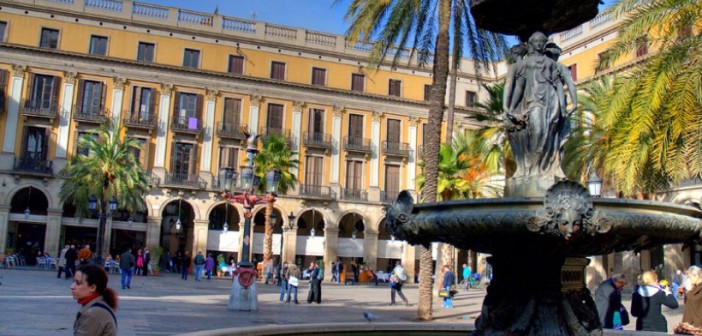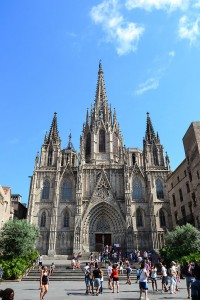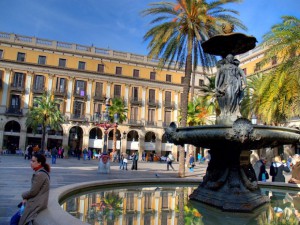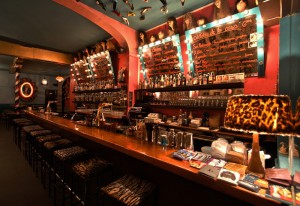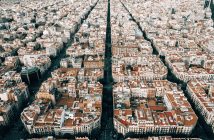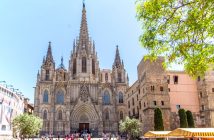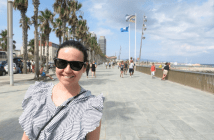Plaça Reial
La Seu Barcelona Cathedral
History
The Barri Gòtic, or Gothic Quarter, and La Rambla, can be easily recognized as the oldest and most historic part of Barcelona, with its Medieval buildings and labyrinthine narrow roads. From the 4th Century until the middle of the 19th century it was entirely enclosed by strong Roman walls and fortifications. Fragments of these walls can still be seen, most notably around Barcelona Cathedral and Calle Avinyo.
Barcelona’s Cathedral, itself a splendid example of Gothic architecture at its finest, was begun in 1298 and completed in 1448. This was the period of Barcelona’s Medieval golden age. As the Mediterranean city’s trade and economy flourished, its architects laid down the foundations of many of what are still the city’s most important buildings today. The church of Santa María del Pi and the Saló de Tinell in Plaça del Rei are some of the most significant legacies of the European Gothic movement.
Barcelona’s administrative centre is located in the nearby Plaça Sant Jaume, which used to be the city’s “forum” and marketplace back in Roman times. Now it is home to both the headquarters of the Catalan government in the Palau de la Generalitat, and the town hall or Ajuntament. It also remains one of the favorite venues for traditional events and activities, such as the dancing of sardanas, and human castles during Barcelona’s Mercé festival.
Sightseeing
Plaça Reial is a busy square just off La Rambla, where you can find many wonderful places to eat and have a drink. The squaregets very busy at night with many clubs in the area attracting tourists and locals. There is also some lovely architecture that can be seen here. The Fountain of Three Graces is in the centre and on either side you will find unique large lanterns, Gaudí’s first commissioned work in the city.
Barcelona Cathedral is also known as La Catedral de la Santa Creu i Santa Euàlia. It is a beautiful work of 11th century architecture with tall pointed towers and smooth arched entrances. Tours of the Cathedral are free during the morning and in the evening. You also may make a donation to visit the roof overlooking the old Gothic neighbourhood.
The Picasso Museum is one of the most visited museums in the city, and perfectly located in the Gothic quarter. It features art work from the early years of Pablo Picasso; much of the work in the museum was created while he was living in Barcelona. The art is arranged in a way that leads you through the artistic growth of Picasso and gives you a better understanding of his thoughts and inspirations. Free entrance to the museum is offered on the first Sunday of every month.
Dining & Nightlife
Bosco is a great restaurant in this neighbourhood, offering daily specials and a set lunch menu along with the chef’s favorite dish, the beef cutlet. This restaurant has done a good job of standing out in a city full of food; the owner and chef take great pride in the food they are serving. There are also tasty options for kids like mac&cheese or chicken fingers.
Address: Carrer dels Capellans,9
Jamboree is a night club located in Plaça Reial. During the week they feature live music and incredible jazz shows. On weekends the club gets very crowded thanks to the resident DJs spinning everyone’s favourite hip-hop and R&B jams. This is also a great place to go if you are trying to avoid the high priced beach clubs, as Jamboree offers slightly more affordable drinks and the entrance fee is lower as well.
Address: Plaça Reial, 17
Sor Rita is a great bar for a million different reason that are not easily described. Aside from their fairly priced and delicious cocktails, something else draws people into this bar. The eclectic decor is a wonderful mix and match of everything you would never think to decorate a bar with, and it works perfectly. This bar is a great place to bring first time visitors to Barcelona, or to start your night with friend before heading to the clubs in the Gothic quarter.
Address: Carrer de la Mercè, 27
How to get there
Plaça de Catalunya is the central hub for transport in Barcelona, so it’s easy to make your way there from anywhere using the metro or FGC trains. However, if you wish to be closer to the centre of the Barri Gòtic there is an L3 metro link at Liceu and Drassanes as well as L4 in Jaume I.

